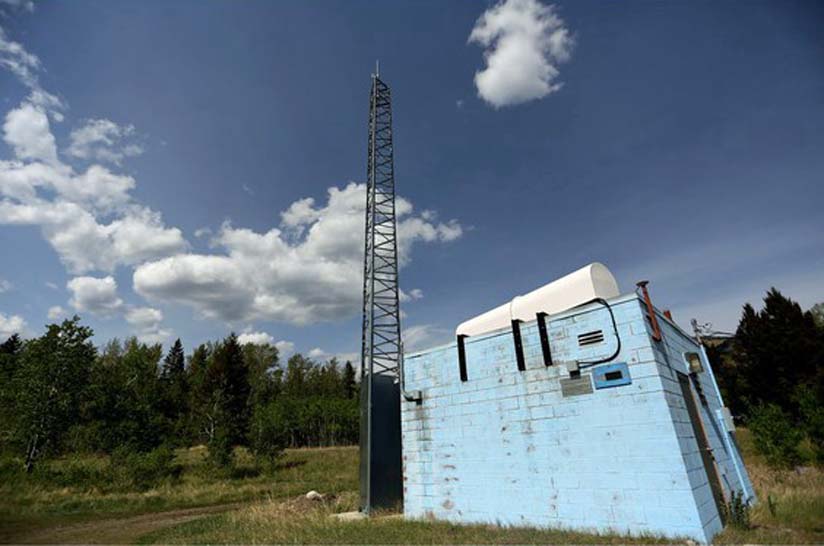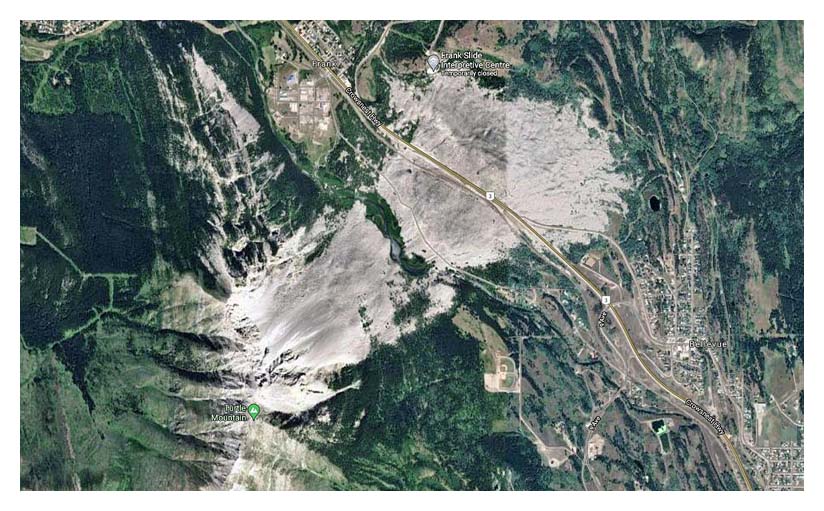
Crowsnest Pass - There was no warning when 30 million cubic metres of rock thundered down Turtle Mountain in the pre-dawn darkness more than a
century ago, travelling at speeds up to 120 kph toward a small coal mining town that was fast asleep.
The destructive limestone came crashing down at 04:10, and buried more than 90 people who were sleeping in temporary dwellings, miners' cottages, tents, and
shacks on the outskirts of town, wiping out 15 percent of the population of Frank.
It was the deadliest rock slide in Canadian history.
Today, 113 years later, scientists say another slide is inevitable, but this time, they'll be prepared.
The province is now using state-of-the-art equipment to monitor the mountain in real time and ensure there will be warning when the rock falls
again.
"Some day, it will fall down," said Todd Shipman, manager for landscape and geohazards at the Alberta Geological Survey, a part of the Alberta
Energy Regulator.
"I mean hundreds of years, or maybe thousands of years, but hopefully we'll have a good system that will warn us ahead of time, and we can plan and there
will be no casualties."
There were plenty of casualties and no monitoring system in place on 29 Apr 1903 when the east face of the mountain came crashing down, moving like dense,
fast-flowing liquid, and covering three square kilometres with rubble in just 90 seconds.
"The Frank Slide was unimaginably terrible. Nobody could have anticipated a rock avalanche that would bury a part of a town," said Monica Field,
manager of the Frank Slide Interpretive Centre.
In the decades that followed, townsfolk fearing the mountain would fall again used paint markings and a tape measure to monitor its movements, a stark contrast
to the technology used today.
The Alberta Geological Survey began keeping tabs on Turtle Mountain in 2005 with high-tech sensors and panels located on the mountain that were effective,
though finicky, and at the mercy of weather and curious rodents.
More than a decade of monitoring has seen mass amounts of data gathered and big improvements in the technology used to understand how the mountain is
shifting.
In spring 2014, the technology used to monitor Turtle Mountain moved off the mountain.
Today, data is gathered from a ground-based Interferometric Synthetic Aperture Radar (InSAR) system with radar antennae that move along a four-metre track to
scan the mountain every few minutes.
"It's a box that shoots radio waves to the mountain and the face, and it measures change in the face," Shipman said.
The high-tech equipment is protected by a weatherproof cover and affixed atop an abandoned pump house with faded blue paint in a dog park across from the
mountain.
The system is leased from an Italian company for around $40,000 a year (the price is at the mercy of the fluctuating value of the Canadian dollar against the
euro) and the information it gathers goes immediately to the Frank Slide Interpretive Centre.
Seconds later, via the Internet, it lands in Italy to be analyzed.
"We're on the leading edge with this technology," Shipman said.
"We've gone from mechanical equipment that's up on the mountain and had a lot of challenges to now something that's off the mountain that we can maintain
safely and measure the face in real-time."
Despite the challenges, the previous equipment has provided Alberta Geological Survey with a lot of information.
"The mountain is moving millimetres per year, but it took us at least 10 years to really verify that's how fast it's moving," said
Shipman.
While millimetres may not seem like much, Shipman believes continued monitoring is important and will remain so for centuries to come because of the
consequences tied to another slide.
"This is a crucial corridor for people and transportation, and we have to know if it's at risk. If it is, and we can avoid any harm to people, to me,
there's not really a high cost to that," Shipman said.
Turtle Mountain is considered Canada's most-monitored mountain, and in the 113 years since the Frank Slide, scientists from around the world have come to the
so-called field laboratory for research.
The site is also a tourist destination, attracting visitors from across the globe.
More than a century after the tragedy, the car-sized chunks of rocks remain, offering drivers on Highway 3 pause, and visitors to the Frank Slide Interpretive
Centre views of a massive and haunting debris field.
"You walk through it and there's no way you couldn't think of the loss of life and the actual event," Shipman said on a recent tour of the
area.
"It's a moonscape. It seems like you're on a different planet."
Six hundred people called the coal mining town of Frank home at the time of the slide, and 100 were living directly in the path of the rocks, on the town's
eastern edge.
Most died, though the exact number of townsfolk killed is not known because only 14 bodies were ever recovered.
"The Frank Slide resonates because it didn't discriminate," Shipman said.
Down a quiet gravel road at the edge of the slide lies a bronze plaque mounted on a boulder that commemorates the slide's victims, and two headstones that
honour two slide survivors who lived into old age.
One headstone is for Gladys Ennis, who was just a baby when the disaster struck and was found choking on mud as the dust settled.
She was the last survivor of the slide at the time of her death in 1995.
Her story and dozens of others are told in the acclaimed Frank Slide Interpretive Centre, where more than a century after the disaster, stories of hope live
on.
There was the man who fought through the slide to flag down an oncoming passenger train with 90 occupants, destined in darkness at full speed for the
rubble.
There were the miners who were buried alive deep below the ground who miraculously made their way out.
"Modern people like to hear the survivors' stories. We all want to believe that we could go through a terrible tragedy and we could survive it. As I say
to the interpreters who we're training, you don't have to work to make this interesting. It just is," said Field.
Field, who has worked at the centre for 31 years, and lived in the area all her life, still gets shivers when she gazes at the rubble outside her office
walls.
"It was never normal and it still isn't after all these years," she said.
"When I drive through the slide or look at it, I feel a sense of awe, that tingling feeling. It's different. It's almost like it's not the real world when
you go through the slide."
Field said one of the most common questions interpretive centre visitors ask is the same question people have been asking for 113 years.
Will the mountain fall again?
It's a question that's become a lot easier to answer after a decade of extensive monitoring.
"Yes," Field explains to visitors.
"It will fall again."
While the timing of when Turtle Mountain will crumble is uncertain, she tells them the monitoring program means "next time, when "Frank Slide 2 - The
Return" happens, there won't be people killed."
Annalise Klingbeil.
(because there was no image with original article)
(usually because it's been seen before)
provisions in Section 29 of the Canadian
Copyright Modernization Act.


